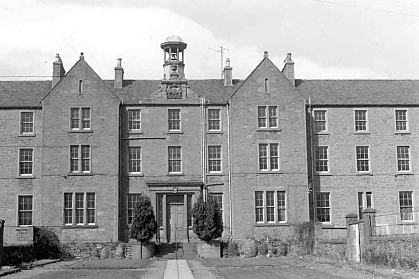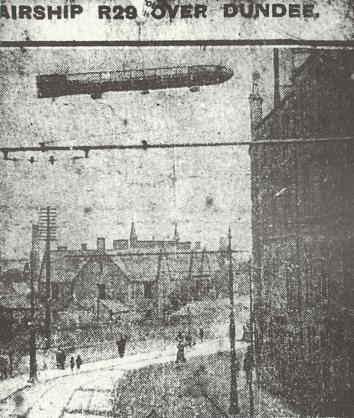

Above left, Dundee's East Poorhouse; above right, Dundee's West Poorhouse.
Between 1845 and 1930, over 70 poorhouses were constructed in Scotland. They were built following the Poor Law (Scotland) Act of 1845, which established parochial boards in rural parishes and in the towns. The poorhouses were not for those paupers who continued to live in the city and who were receiving outdoor relief in the form of small weekly sums of money. The regime, diet and living conditions in poorhouses (i.e., indoor relief) were austere, partly to discourage applications from those who could rely on family support instead. On the other hand poorhouses provided medical and nursing care of the elderly and the sick, at a time when there were few hospitals and private medical treatment was beyond the means of the common people.
In 1853 when the "Dundee Poorhouse" was designed, it was intended to house 800 paupers, 100 sick, and 100 lunatics. The main building was an H-shaped structure, three stories in height. A separate block for sick and lunatic inmates stood to its north. The first inmate was admitted to the poorhouse on 19th November, 1856. Later, in 1864 when Liff & Benvie parish joined together with Dundee to build another poorhouse, the Dundee Poorhouse became known as the East Poorhouse or the East House Poor Law Institution As you would expect, the East Poorhouse was located in the eastern side of Dundee. From the Overgate which was in the centre of Dundee, it was approximately 1 mile to the north-east.
Dundee's West Poorhouse was built in 1864 and was known initially as the Poor House of Liff and Benvie. (Liff and Benvie was the parish immediately to the west of Dundee.) It was erected at the north side of Blackness Road and opened its doors on Tuesday 5th April 1864. When built, it could accommodate up to 200 inmates. Male quarters were at the west of the site, and female at the east. Male and female lunatics were located at the far end of each section. In 1879, Dundee and Liff & Benvie joined forces and from that date, it became known as the West or Western Poorhouse. In time, the two poorhouses accepted different clientele. The West Poorhouse mostly accommodated the elderly, infirm or insane while younger, more fit paupers were accommodated in the more spacious East Poorhouse. As you would expect, the West Poorhouse was located in the western side of Dundee. From the Overgate which was in the centre of Dundee, it was approximately 1 mile to the west. From the address given on Ann's death register, we know that she had been resident in the West Poorhouse.
Scottish law mandated a strict, regulated life for inhabitants of all the poorhouses in the country. These procedures and rules were established to ensure that funds were made available to the truly needy who were incapable of maintaining themselves or their dependents. The government was very concerned that funds raised for the relief of the poor were not perverted to the maintenance of idleness and vice. So, they required that people in the poorhouses work (with the exception of those who clearly could not) and they required them to live in a regulated environment. If parochial boards desire to discourage indolence, to detect imposture, to check extravagance, and to reform or control vice, they must make work, confinement, and discipline, the conditions upon which paupers of this class are relieved.
Thus, one could not just go up to the doors of the Poorhouse and ask for entry. There was a rigorous process to go through before they could finally be admitted into this establishment. Inquiries would be made about an applicant's character along with his life to date and this report would be given to the Relief Committee. If accepted, he would be stripped of his garments, given a bath and a haircut, and examined by a doctor who would determine if he should be placed in a sick-ward or in the part of the Poorhouse established for his "class" (i.e., for men over 15, women over 15, boys (2-15), girls (2-5), and infants). The applicant then would be given workhouse clothes and be sent to the designated ward. Males would be dressed in fashionably-made sac coats of brown beige and a waistcoat of the same material, buttoning up to the throat, 'peg top' trousers of grey tweed and 'guid braid bonnets'. I couldn't find a description of clothes for the women.
If the Relief Committee had some doubt if the applicant was truly needy (e.g., he was able to work, or his family was able to support him), he would be placed in the probationers' or 'test' ward where he had to endure a tougher, more restrictive regime than in other wards. The assumption was that many applicants would either refuse indoor relief in the test ward or, if admitted, would not endure the test ward for long before either discharging themselves or absconding. In Dundee, one test was to have paupers work in the probationary sheds which were isolated from the other inhabitants. These sheds were about the size of a prison cell. Two of the sheds were equipped for stone-breaking and they only had a three quarters roofed area. These jobs were given to the worst class of applicant as well as convicts returning to society. Dundee's second test labour was sack sewing and this was a far lighter mode of work but again a solitary occupation. After a week, supervisors would note how many sacks an individual has sewn and if that individual wished to stay at the poorhouse, he had to sew the same amount of sacks or have his food ration cut. Most individuals did not stay long in the poorhouse once they had been put in the test sheds.
All able-bodied paupers were induced to engage in some kind of industrious occupation through weekly payment of part of the proceeds of their work that they could spend on their liberty-days. The work was usually boring, hard and degrading. Examples included crushing bones and picking oakum. Cooking and cleaning in the workhouse kept many busy.
A poorhouse diet was generally of poor quality. Breakfast usually consisted of 7oz of bread and 1 and 1/2 pints of gruel. Lunch was not much better and often consisted of a maximum of 1 and 1/2 pints of poor quality vegetable soup. Dinner would consist of 6oz of bread and 2oz of cheese. Due to this poor diet, poorhouse residents often suffered from malnutrition. In the 1850s, the vicar of Stoughton and Racton in West Sussex wrote to the Guardians of the Westbourne Workhouse requesting that (as a matter of Christian charity) second helpings of gruel be provided on Christmas Day. He was informed in no uncertain terms that if the rations were raised above the minimum required to keep body and soul together, the result would be laziness, fecklessness, and hordes of otherwise able bodied people clamouring to get in.
Here are some of the rules that regulated Poorhouse residents:
- Every poor person, upon admission to the Poorhouse, or on return from a temporary leave of absence, shall be searched by the proper officer, and shall be prevented from carrying into the Poorhouse any prohibited article.
- Each class, or subdivision of a class, shall respectively remain in the part of the Poorhouse assigned to them without communication with any other class, or subdivision of a class. (Note: By entering a workhouse, paupers forfeited responsibility for their children. Education was provided but pauper children were often forcibly apprenticed without the permission or knowledge of their parents.)
- All the inmates in the Poorhouse, except those disabled by sickness or infirmity, persons of unsound mind, and children, shall rise, be set to work, leave off work, and to go bed at such times, and shall be allowed such intervals for their meals as the House-Committee shall direct,— and these several times are to be notified by the ringing of a bell.
- Half an hour after the bell shall have been rung for rising, the names of the inmates shall be called in the several wards, where every inmate belonging to each ward must be present to answer and to be inspected.
- No inmate shall have or consume any spirituous or fermented liquor; and no inmate shall have or consume any tobacco, or food, or provision, other than is allowed in the dietary.
- The boys and girls who are inmates of the Poorhouse shall, for three or more of the working hours of every day, be instructed in reading, writing, arithmetic, and the principles of the Christian religion, and such other instruction shall be imparted to them as shall fit them for service or other employment, and train them to habits of usefulness, industry, and virtue.
- No person shall visit any inmate of the Poorhouse except by permission, and subject to such restrictions and conditions as the House-Committee may prescribe; and such interview shall take place, except where a sick inmate is visited, in a room separate from the other inmates, in the presence of the House-Governor, Matron, Porter, or other person duly authorised by the House-Committee.
- No inmate shall be allowed to possess, or to read in the Poorhouse, any book or printed paper of an improper tendency; and no written paper of an improper tendency shall be allowed to circulate, or to be read aloud among the inmates.
- No inmate shall smoke within the Poorhouse, nor shall have any matches or other articles of a highly combustible nature in his possession.
Inmates who neglected to observe the poorhouse rules, or engaged in unacceptable behaviour (e.g., making noise when silence was ordered, using obscene or profane language, reviling or insulting a person by word or deed, threatening to strike or assault any person, not duly cleansing his person, refusing or neglecting to work, pretending sickness, playing at cards or other games of chance, or behaving improperly at public worship or prayers) were deemed DISORDERLY and would be punished by having to work 2 extra hours per day and/or by withholding all milk or buttermilk from his meals.
If this behaviour was repeated within seven days, or if the inmate engaged in more serious offenses (e.g., reviling officials, disobeying orders, attempting to bring in spirits, committing an indecency, being drunk, or attempting to leave the poorhouse without permission) was deemed REFRACTORY and faced punishment of solitary confinement or having to appear in front of a magistrate. Both disorderly and refractory inmates were also subject to being required to wear clothes that were different from other inmates.
Note that many of the rules governing life in poorhouses had the qualifier except those disabled by sickness or infirmity included within the language of the regulation. Ann's life would not have been regulated so harshly.
Sources
Various websites, including
Dundee Poorhouses: http://www.workhouses.org.uk/index.html?Dundee/Dundee.shtml
Liff & Benvie Poorhouse: http://www.fdca.org.uk/poorhouse/poorhouse2.htm
Poor Relief: http://www.scan.org.uk/knowledgebase/topics/poorhouses_topic.htm
Scottish Poorhouse Rules: http://www.workhouses.org.uk/index.html?Dundee/Dundee.shtml
Wikipedia: Workhouse: http://en.wikipedia.org/wiki/Workhouse